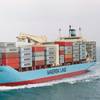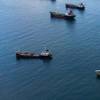The U.S. Department of Transportation’s Saint Lawrence Seaway Development Corporation (SLSDC) and the Canadian St. Lawrence Seaway Management Corporation (SLSMC) opened the binational waterway’s 45th navigation season. This season marks the beginning of mandatory Automatic Identification System (AIS) use on commercial vessels entering waterway in North America to employ this technology as a requirement for transit.
“AIS represents a significant improvement in marine transportation navigation, integrating vital navigation data long available through our Vessel Traffic Control Centers (VTCCs) with electronic chart display technology at the fingertips of officers on the bridge,” said SLSDC Administrator Albert Jacquez. “As a result, captains, mates and pilots receive information on the exact location in any weather of ship traffic from name, location, size and the Seaway.
The AIS uses data from ship-to-shore, shore-to-shore, and shore-to-ship, thereby enabling a constant two-way communication between mariners and the three Seaway VTCCs. Originally developed primarily for safety reasons, AIS has become increasingly of interest to maritime security officials in the post 9/11 environment as it offers the ability for them to track with precision any vessel carrying the transponder.
A transponder-based system employing mature global positioning system (GPS) and differential GPS technology that transmits data on VHF frequencies, AIS promises to improve safety, security and efficiency on the St. Lawrence Seaway from its entry point at St. Lambert Lock to Long Point, Ontario on Lake Erie. The St. Lawrence Seaway is the first inland direction as well as detailed data on currents, windspeed, water levels, and lock order turns.”
Guy Véronneau, President and CEO of the SLSMC, agreed with Jacquez on the significance of AIS. “Requiring commercial vessel traffic to use AIS signals the Seaway’s commitment to enhancing efficiency and improving traffic scheduling,” said Véronneau. “With AIS, Seaway employees can safely and efficiently schedule lockages and tie-up services, as well as inspections and pilotage requirements with more precision.”
In the near future, permanent installation of AIS equipment will be required onboard commercial vessels in the entire Great Lakes St. Lawrence Seaway System from the Lakehead in Duluth, Minnesota, to traffic entering the Gulf of St. Lawrence on the Atlantic. Adoption of the technology, which has been approved by the International Maritime Organization, was embraced early on by the Canadian Shipowners Association and the Shipping Federation of Canada, both of which provided technical and financial assistance. The Department’s Volpe National Transportation Systems Center served as technical contractor for development of the AIS project, which began almost a decade ago. AIS will soon be required internationally on commercial vessels.
Featured videos

Send in the Drones (to deep, dark, confined maritime spaces)

Taking the First Step Toward Autonomy
October 2024
 Read the Magazine
Read the Magazine

 Read the Magazine
Read the Magazine
This issue sponsored by:

Cyber Threats to Maritime Vessels Grow Exponentially
Subscribe for
Maritime Reporter E-News
Maritime Reporter E-News is the maritime industry's largest circulation and most authoritative ENews Service, delivered to your Email five times per week









